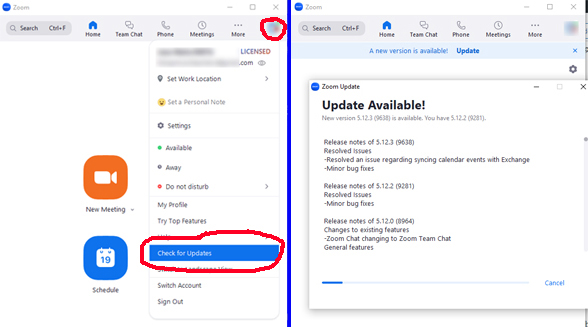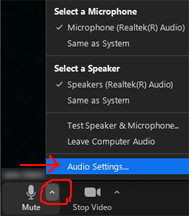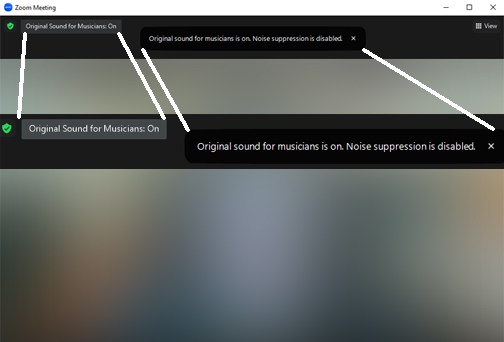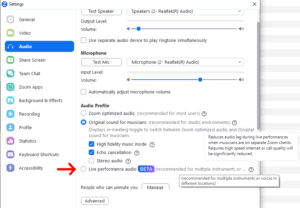{Here is the current procedure as of August 2024.}
UPDATE January 2025: Recent updates to Windows and some Dell Computer system apps may be conflicting with Zoom and blocking music-sounds entirely. (One power-user in my studio reported that Windows settings were blocking Dell settings that would have reinstated the Zoom settings.) Click the links for solution resources; YMMV.
When using Zoom for online music lessons, both the teacher AND the student need to avoid using Zoom’s default sound settings! Zoom is primarily a verbal-communications app, so the default settings are designed to cancel out sustained background noise, high pitches etc. — the type of sounds that are generated by musical instruments! Zoom has had an “original sound” setting since 2020, which curbs their aggressive filter for these types of sounds. In the fall of 2022, Zoom specifically labeled their Original Sound feature to say “Original Sound for Musicians.” Clearly they are aware that using Zoom for music lessons is a very popular application! If you’ve never seen the “for Musicians” addition, or if you never got the audio settings just right, here is a quick guide to the desktop version of the app. The iPad settings are covered in this post.
Follow these visual steps to update the Zoom app on your desktop or laptop, and configure the Audio settings for music lessons.
Update the app.
Open Zoom and click on your profile badge in the upper right corner. Then click “Check for Updates” in the drop-down. If an update is available, confirm you want to install the update.
Access the Audio Settings.
After the update is installed, run the Zoom app. Click the Settings gear icon below your profile badge in the top right corner. Select the Audio category in the column down the left side of the Settings box. (You can also adjust the audio settings from within an active meeting. In the lower left corner by the microphone icon, click the up-arrow [carat] and select “Audio Settings” at the bottom of the pop-up menu.)

Adjust the Audio Settings.
Below — what the Audio Settings window looked like in August 2024. Uncheck the “Automatically adjust microphone volume” box and increase your microphone volume to over halfway — at least this works well for me!
Next, THIS IS THE MOST IMPORTANT STEP: In the Audio Profile section, select “Original sound for musicians.” You’ll have to toggle the sub-selections “High fidelity music mode”, “Echo cancellation” and “Stereo audio.” The second and third options may compromise your connection speed and/or the sound quality for either you or the person on the other end. Experiment to see if they help at all. If they don’t, you can leave them unchecked.
 Here are the Zoom descriptions of the Original Sound for Musicians settings: “Enables in-meeting option that disables Zoom noise suppression and removes high pass filtering and automatic gain control.”
Here are the Zoom descriptions of the Original Sound for Musicians settings: “Enables in-meeting option that disables Zoom noise suppression and removes high pass filtering and automatic gain control.”
High-fidelity music mode: “Optimizes Zoom audio for highest quality music. It can… consume greater network bandwidth. For best results, an ethernet connect (not Wi-Fi) is strongly recommended.”
Echo cancellation: “Prevents echoes from being captured or created… Unless you are using headphones or playing a musical instrument, we recommend that you enable this option.” (In other words, leave disabled when playing an instrument or using headphones.)
Stereo audio: Encodes mic audio in stereo. Requires a stereo-capable microphone or audio interface.
Live performance audio (BETA FEATURE): recommended for multiple instruments in different locations, “…Requires high-speed internet”
In Meeting, Turn On “Original sound for musicians.”
When you’re in a live meeting, click the Original Sound for Musicians: off selection box near the top right of your video window. Read this as saying “Original Sound IS OFF.” When you click it, it will then read Original Sound for Musicians: on and you are good to go.

To see how much more control the desktop version of Zoom gives you than the iPad version, check out how to perform this same function on an iPad.
More Helpful Hints for Zoom Music Delivery
- If you or a student have not used Zoom for a few weeks or months, make sure you have both downloaded the latest updates!
 Optimizing the Zoom settings cannot overcome the deficits of poor microphones! Most laptops have very basic built-in microphones, and so do some older desktops. Anyone planning to use Zoom extensively to transmit music should invest in a moderately priced USB external microphone. I recommend the Blue Yeti mic [affiliate link], which I’ve been using since 2020 for online teaching.
Optimizing the Zoom settings cannot overcome the deficits of poor microphones! Most laptops have very basic built-in microphones, and so do some older desktops. Anyone planning to use Zoom extensively to transmit music should invest in a moderately priced USB external microphone. I recommend the Blue Yeti mic [affiliate link], which I’ve been using since 2020 for online teaching.- If background echo is a problem for either participant, first experiment with Echo Cancellation in the Zoom Audio Settings. In tandem with that, have one or both participants wear headphones!
- It probably doesn’t need to be said, but: Avoid giving music lessons to students who can only connect via a cellphone!
BETA Zoom setting for “Live Performance Audio”
 Since March 2023, Audio Settings displays an additional Audio Profile, titled “Live performance audio BETA (recommended for multiple instruments or voices in different locations)”. Click to enlarge the image. The explanatory text overlays describe this feature as helping to reduce latency for playing “together” over Zoom, but warn that a fast internet connection is needed.
Since March 2023, Audio Settings displays an additional Audio Profile, titled “Live performance audio BETA (recommended for multiple instruments or voices in different locations)”. Click to enlarge the image. The explanatory text overlays describe this feature as helping to reduce latency for playing “together” over Zoom, but warn that a fast internet connection is needed.


I’m a beginner at teaching online piano lessons. Do some teachers use
an iPad while others use a notebook, etc? What’s best in your opinion?
Thanks in abundance!
carmel17mldrv@aol.com
Thanks for your question! While iPads are convenient and most teachers use them for other apps, the Zoom app for iPad does not seem to have as many sound-quality options as the version for desktop or notebook. The iPad built-in microphone is also very limited for transmitting music. Notebook microphones are limited too, but it’s usually easier to connect an external mic to a notebook, via USB, than to an iPad. So I usually ask students to try to connect to their Zoom lesson using a laptop with an external microphone, if possible.
I tried so many ways for my music lesson.
But my audio sound not so good.
I even bought a blue yeti mic and set audio setting exactly what they recommend.
I appreciate the work you put into these instructions. I’ve been dealing with this for months now, and no combination of Settings has ever allowed the teacher to hear anything but the students Voice.
Skype has the same issue… But I found that if the student uses the Web version instead of the app, Both student and teacher can hear each other’s instruments and any vocals.
You would think that if Skype could do it, Zoom Would have come up with a better solution by now.
Zoom seems to have killed audio for lessons with its newest update. Have tried all these steps, and did so under supervision of tech support from zoom, and it still doesn’t work. Any updates on the situation you know of?
While I haven’t had the problems you’ve described, I have noticed that it sometimes helps to adjust the microphone levels, as mentioned in the earlier comment below, and play with the echo-cancellation toggle box. Just make sure you only test one variable at a time, on one side at a time (you or the student).
It is now February of 2023 and my Zoom app has updated a couple of times since I last revised my blog post. I’ll provide a new revision if any of the features seem to be different now.
Hi, thank you for your post. I teach online piano lessons and the last update has created many difficulties. One thing I have forgotten to ask students was whether or not the “Automatically adjust microphone volume” box was selected. The previous update from 2021 worked better for me. I wonder if other musicians/teachers have faced the same problems.
Thanks for your reply and see my comment above! I’ll update my Zoom post again if anything seems to have changed since November.